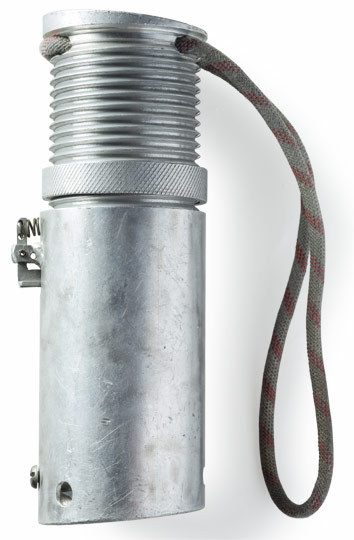In 1984 options for protecting offwidths were limited: T-shaped Forrest
Titons and Chouinard tube chocks fit constrictions to six inches, but proved useless in parallel
cracks. Big Tri-Cams routinely dislodged and slid down the rope. A smattering of homemade big
cams, drilled full of holes, were available on the underground market, but they were built from
unknown alloys and untested. Nothing existed for squeeze chimneys or for the widest cracks; the
bravest climbers just ran them out. Most just ran away—until Colorado State student Craig Luebben
developed a new protection device for his senior honors thesis.

[Photo] David Swift
Mired in mechanical engineering coursework
but dreaming of climbing, Luebben drew up ten
different ideas for protecting wide cracks. The
eleventh occurred the weekend before he had to
submit the designs to his supervising committee.
While Luebben was climbing The Saber in
Rocky Mountain National Park, another team—
Kent Wheeler and Chuck Grossman—arrived at
his belay ledge. “I’m not sure if we’re on the
right route,” said Wheeler. “In fact, I’m not even
sure if we’re on the Petit Grepon.” “You’re not,”
Luebben informed them. “You’re on The Saber.”
On the descent, Grossman, a formidable crack
climber, uttered the fateful words “expandable
tube” to Luebben. The idea of the Big Bro—
named after the line “Big Brother is Watching
You” in George Orwell’s novel 1984—was born.
Luebben built seven prototypes of the Big Bro in
CSU’s engineering machine shop (the Big Bro at
left is the first of these). The original prototypes
had inner tubes that could rotate 180 degrees to fit both
constricting and parallel cracks. The parallel
mode almost always seemed more stable, and in
1986 Luebben refined the design for production.
Four sizes of Big Bros, protecting cracks from 3.2
to 12 inches, hit the market in 1987.
The invention did not result in immediate wealth for its creator. On an
extended road trip after graduation,
Luebben found himself climbing with
quarter-sized holes on the big toes of
his EBs. (He’d switch them onto the
wrong feet for crux pitches.) In a desperate attempt to raise funds for new
shoes and beer, Luebben posted a
note on Yosemite’s Camp 4 bulletin
board: “Big Bro expandable tube chock prototypes for sale, $100 each.” Scrawled a Valley
climber, “You’re way dreamin’, dude.”
In 1987 Luebben and his then-girlfriend Sari
Schmetterer, funded in part by Warren Harding,
started a company called Mountain Hardwear to
sell Big Bros and climbing apparel. On their first
sales trip, the buyer at Chouinard Equipment in
Ventura ridiculed them: “No one is ever going to
buy those things.” Luebben later sold the name
“Mountain Hardwear” for $1,500. Schmetterer
went on to found Stonewear Designs.
Luebben still believed in his product, and the Big
Bro enticed him and a group of accomplices into
the first ascents of numerous wide climbs,
sometimes using up to fourteen Big Bros in a
single pitch. As the number of first ascents
increased, Luebben says he soon realized that
you didn’t have to be that good at climbing
offwidths to be one of the best.
Rock & Ice wanted to review the Big Bro, but
the editors didn’t actually want to lead any
offwidths. They recruited Luebben to climb with
them—which led to one of his current livelihoods, as a professional writer.